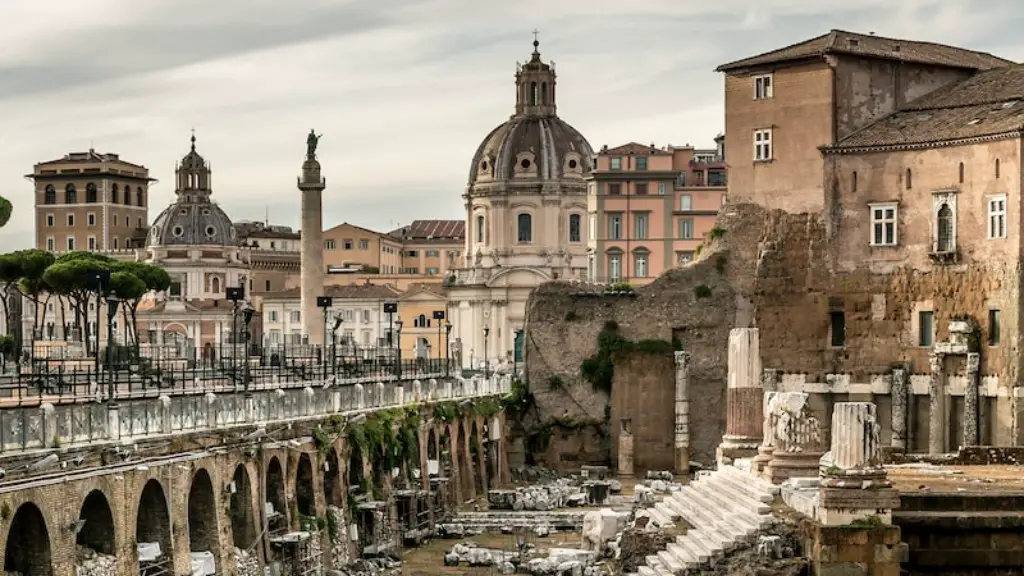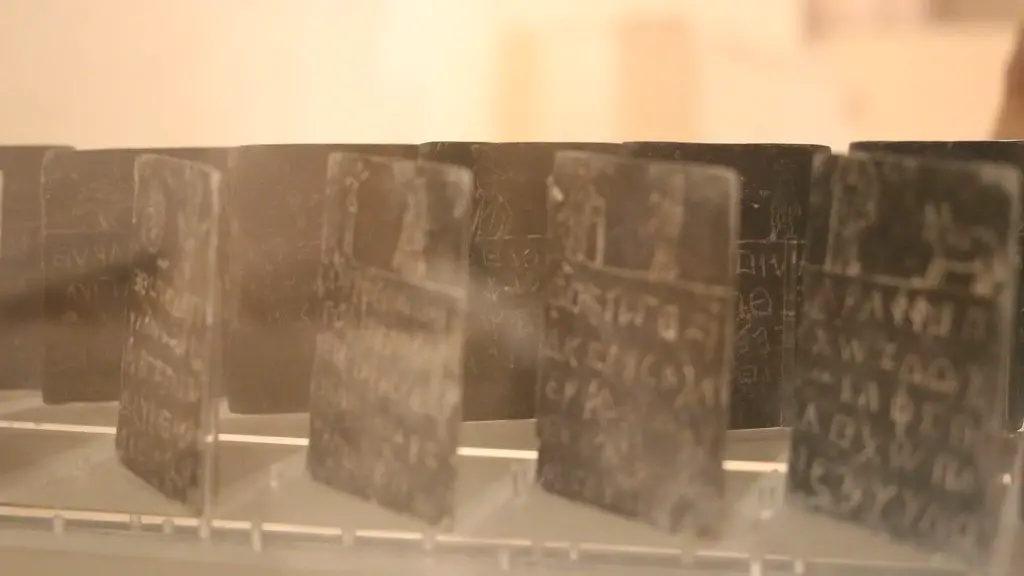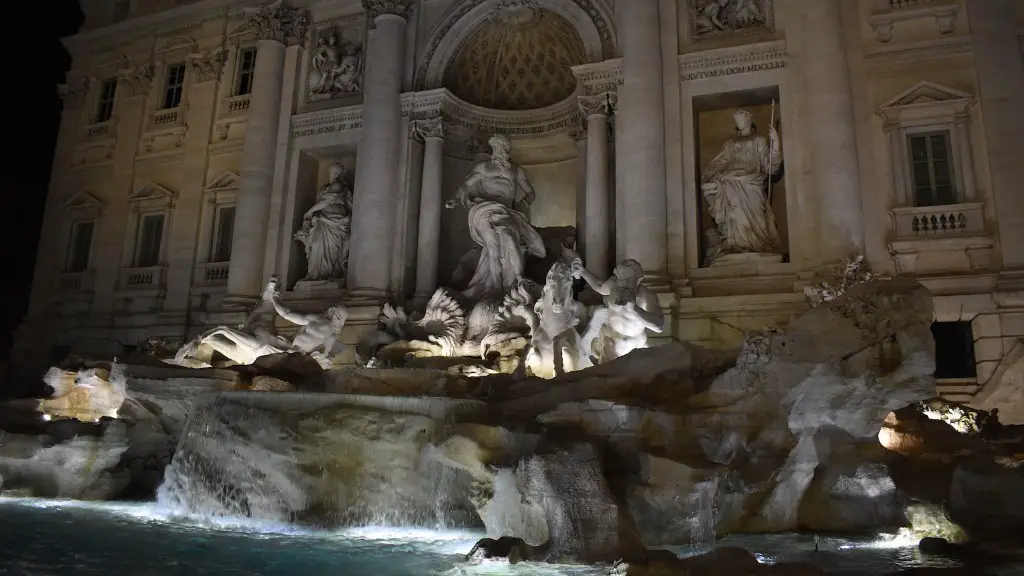In ancient Rome, the Roman state created many public works. Notable examples include the Appian Way, the aqueducts, and the Colosseum.
The ancient Romans were responsible for the creation of many things that are still in use today. They created roads and public toilets, as well as the arch and concrete.
What did the ancient Romans build?
The Roman Empire was one of the most advanced civilizations of its time. For the first time in history, their potential was fully exploited in the construction of a wide range of civil engineering structures, public buildings, and military facilities. These included amphitheatres, aqueducts, baths, bridges, circuses, dams, domes, harbours, temples, and theatres. The engineering and construction techniques used by the Romans were far ahead of their time and have been studied and admired for centuries.
The Romans were the very first to invent an underfloor heating system in buildings. This is one of their very first achievements. They did this by using small pillars to raise the ground level of a build, leaving a small space where heat could circulate under the floor.
What are 3 things the Romans invented
1. Cement: The Roman Empire was responsible for the invention of cement, which is a key ingredient in concrete. Concrete was used extensively by the Romans for construction purposes, and it is still one of the most popular building materials in the world today.
2. Sanitation: The Roman Empire was also responsible for the development of many early sanitation systems. These systems were designed to improve public health and reduce the spread of disease. Some of the earliest examples of public toilets and sewers can be found in Rome.
3. Roads: The Roman Empire built an extensive network of roads that spanned across Europe and Asia. These roads facilitated trade and transportation, and many of them are still in use today.
4. Social Care and Welfare: The Roman Empire established early systems of social care and welfare. These systems provided assistance to the poor and needy, and helped to improve the quality of life for many people.
5. Julian Calendar: The Julian calendar, which is still used in some parts of the world today, was first introduced by the Roman Empire.
6. Elements of Surgery: The Roman Empire was responsible for the development of many surgical techniques and procedures. These techniques and procedures laid the foundation for modern surgery.
Roman architecture is characterized by its use of the arch and vault. The arch is a curved structure that allows for the support of a heavy weight, while the vault is a roofing system that spans a large space without the use of pillars. These two innovations allowed the Romans to create large, open spaces that were not possible with the Greek architectural style.
In addition to the arch and vault, the Romans also perfected the use of concrete. Concrete is a material that is extremely strong and durable, making it an ideal material for buildings. The Romans used concrete to build both domestic and public buildings, such as the Colosseum.
Aqueducts were another innovation of Roman architecture. Aqueducts are a system of channels and bridges that are used to transport water from one location to another. The Roman aqueducts were so well-designed that many of them are still in use today.
Finally, the Romans also built triumphal arches to commemorate their military victories. Triumphal arches are large, ornate structures that were built to honor the Roman generals and their troops.
What are 5 things the Romans are most famous for?
There are many things that we take for granted in modern life that were actually invented by the Ancient Romans! Here are just a few examples:
Roads: The old proverb “all roads lead to Rome” (usually interpreted as “many paths may lead one to the same goal”) stems from the fact that originally they sort of did, or rather they came from Rome. The first Roman roads were built about 3,000 years ago and were made from stone blocks laid in a very precise way so that they were strong and level.
Central heating: The Roman baths were famous for their central heating systems, which used hot air rising from a furnace to circulate around the building. This was a very sophisticated system for its time and was used to heat not just the baths but also public buildings and private homes.
Concrete: Roman concrete was a revolutionary building material that allowed the construction of huge structures like the Colosseum and the Pantheon. It was made from lime, sand, water and a volcanic rock called pozzolana, which acted as a binding agent.
The calendar: The Roman calendar was originally based on the lunar cycle but was later reformed by Julius Caesar to include a year of 365 days
Aqueducts were pipelines that brought fresh water from the mountains to areas without water. Essentially, these aqueducts provided fresh water to urban areas in the Roman Empire.
Roads were another invention of the Roman Empire. The roads allowed for trade and transportation of goods and people.
Concrete buildings were another invention of the Roman Empire. The use of concrete allowed for the construction of stronger and taller buildings.
Medical tools for the battlefield were another invention of the Roman Empire. These tools allowed for the treatment of injuries sustained in battle.
The Julian Calendar was another invention of the Roman Empire. This calendar was used to track the passage of time.
What are the Romans best known for?
The ancient Romans were a people known for their military, political, and social institutions. They conquered vast amounts of land in Europe and northern Africa, built roads and aqueducts, and spread Latin, their language, far and wide.
The Roman Colosseum is one of the most iconic buildings in the world, and it’s thanks in part to its use of cement. Cement is a very strong building material, and the Romans were able to make it using resources that were readily available to them, like volcanic ash and rock. Scientists believe that the use of this ash is what has allowed the Colosseum to stand the test of time.
What did the Romans invent kids
The ancient Romans were a astonishingly inventive people. They may have lived centuries ago, but they invented many things that we still use today. They invented concrete, newspapers, books, calendars, and central heating! Just imagine how different our world would be without these inventions. It’s incredible to think about what else they could have invented if they had had more time. Thank you, ancient Romans, for all your contributions to our world!
Arches are a key element in Roman architecture and engineering. They are used in a variety of structures, from bridges and aqueducts to amphitheatres and sewers. Even today, the Roman numeral system is still used in many different ways.
Did Romans invent concrete?
The ancient Romans were among the first to create and use concrete extensively in their construction projects. By 200 BC, they had mastered the use of this material and were using it in the majority of their buildings. The secret to their success was a mix of volcanic ash, lime, and seawater. This combination resulted in a strong and durable concrete that could be used for all sorts of construction projects.
The Romans invented cement, which was stronger than stone. They designed huge arches and domes with it. They also used concrete to build more than 50,000 miles of roads. This helped unify the empire. Aqueducts carried water from the countryside to the city.
Did the Romans invent roads
The Via Appia was the first and most famous great Roman road. It was built in 312 BC and ran from Rome to the south-eastern coast of Italy. The Via Appia was used by the Roman army to transport troops and supplies, and by Roman citizens to travel to other parts of the country. The Via Appia was also used by traders to transport goods to and from Rome.
Here are 10 fun facts about Ancient Rome for kids:
1. Rome was founded by two brothers, Romulus and Remus, who were nursed by a she-wolf.
2. The Ancient Romans worshipped a lot of different gods and goddesses.
3. Sometimes the Romans would flood the whole Colosseum or Circus Maximus for a boat battle.
4. Ancient Rome is underground! You can still visit some of the ancient Roman sewers and water systems.
5. The Romans were famous for their public baths.
6. The Roman roads were so well built that some are still in use today.
7. Julius Caesar was assassinated by a group of senators who were afraid of his power.
8. The first Emperor of Rome was Augustus Caesar.
9. Rome was sacked by the Visigoths in 410 AD, and by the Vandals in 455 AD.
10. The last Roman Emperor was Romulus Augustus, who was overthrown by the Germanic leader Odoacer in 476 AD.
What is a weird fact about Roman?
The Roman civilization was a very advanced one, and they had some interesting ways of taking care of their teeth and preventing bleeding. Powdered mouse brains were used as toothpaste, and at one banquet in Rome, the guests were served with hundreds of ostrich brains! The founders of Rome, Romulus and Remus, were supposedly raised by a wolf, and cobwebs were used to stop bleeding. All of these methods may seem strange to us now, but at the time, they were the best available options.
The Roman Empire was one of the most influential periods in human history. Many of the things that we take for granted today were actually innovated by the Romans. From fast food to advertising and trademarks, the legacy of the Roman Empire can still be seen in our modern world. Here are 13 things the Romans did for us:
1. Fast food: The Romans were the first to introduce street stalls and ‘food on the move’ as we might think of it today.
2. Advertising and trademarks: The Romans were the first to use advertising and trademarks to promote their businesses.
3. Plumbing and sanitation: The Romans were the first to develop public plumbing and sanitation systems.
4. Towns: The Romans were the first to develop the concept of towns, with distinct areas for living, working, and bathing.
5. Roads: The Romans were the first to construct roads that were wide enough for carts and chariots.
6. Our calendar: The Roman calendar was the first to use the concepts of months and years.
7. Concrete: The Romans were the first to use concrete in buildings and construction.
8. Aqueducts: The Romans were the first to build aqued
What are 5 facts about ancient Rome
There are a few things that you should know about Rome before you visit:
1. Rome was founded in 735 BC, although some historians believe it was founded in 753 BC by Romulus.
2. Cats are free to roam in Rome – you’ll see them everywhere!
3. The Roman’s eyes were bigger than their stomachs – they loved to eat!
4. Men could only wear togas in Ancient Rome.
5. Women wore stolas – a long, flowing garment.
6. The coins in the Trevi Fountain are there for good luck!
7. The Roman breathalyzer was invented by the Roman physician Celsus.
8. Colosseum Casualties were often very high – sometimes even in the thousands.
Rome is most famous for its incredible history, which is evidenced by its many famous landmarks and museums. These include the Colosseum, Trevi Fountain, Roman Forum, Vatican Museums and St. Peter’s Basilica. These popular attractions are what make Rome one of the most visited cities in the world.
Conclusion
The ancient Romans were responsible for creating a number of important things that have shaped the world as we know it today. Some of their most notable creations include the Roman Republic, the Roman Empire, the first paved roads, the aqueducts, and the Colosseum.
The ancient romans created a lot of things that are still used today. They invented concrete, public baths, and the aqueduct. They also built roads, bridges, and dams.





